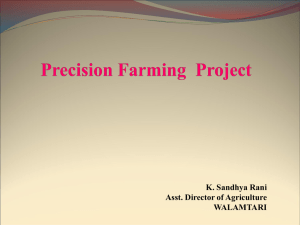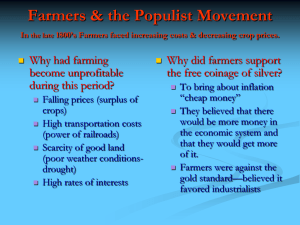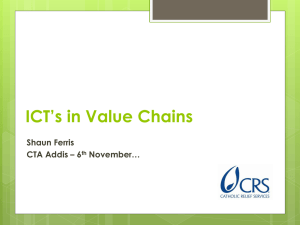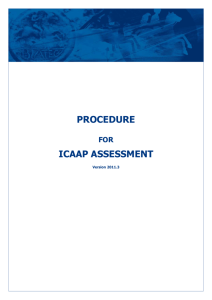Issues in agriculture sector
advertisement
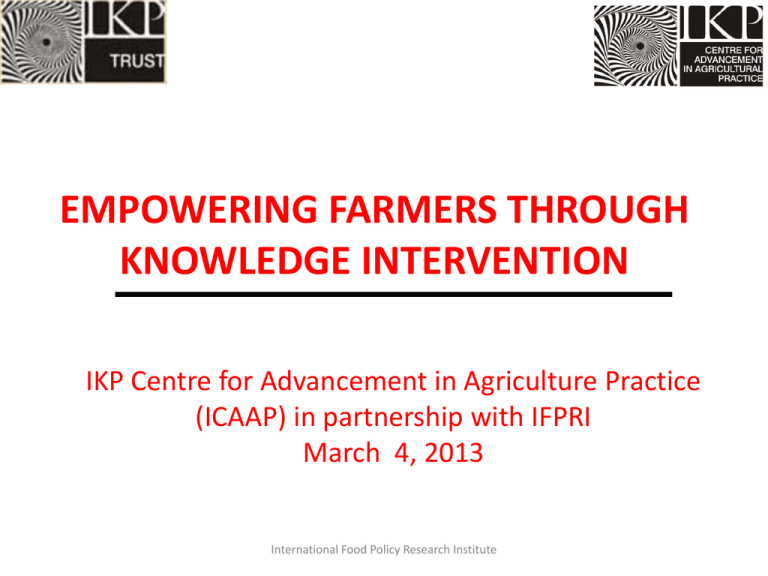
EMPOWERING FARMERS THROUGH KNOWLEDGE INTERVENTION IKP Centre for Advancement in Agriculture Practice (ICAAP) in partnership with IFPRI March 4, 2013 International Food Policy Research Institute Issues in agriculture sector • Small land holding pattern i.e. Average size of land holding 1.23 ha per farmer • Access to quality inputs i.e. spurious seeds in the market • Increased cost of inputs • Labor scarcity i.e. migration to urban and unremunerative farming • Depends of agriculture on weather i.e. Climate change • Poor rural infrastructure i.e. roads, storage, warehouse and market International Food Policy Research Institute Issues in agriculture sector • No proper management of irrigation i.e. surface irrigation • Access to credit from financial institutions i.e. Rural penetration is poor by public and private banks and dominated by money lenders • Poor risk mitigation i.e. Production and price risk • Use of technology is inadequate i.e. weak extension mechanism • Subsidy driven policies i.e. Fertilizers • Exploitation of natural resources i.e. Ground water, soil health degradation International Food Policy Research Institute Issues in agriculture sector • Production not aligned with emerging demand pattern i.e. cereal based production Vs high value commodities (F&V) and dairy products • Poor investment in research, education and extension • Poor post harvest management and value addition • Weak institutional mechanism in agriculture International Food Policy Research Institute Background – the importance of information • Generalized vs local, context-specific • Local info = more resource intensive but could be more valuable for farmer • Farmers differ in their information searching behaviours and information needs International Food Policy Research Institute Where do farmers get their info? % farmers for each info source (NSSO, 2005) Not accessed any source Other progressive farmers Input dealer Radio TV Newspaper Extension worker KVK Private agency/NGO International Food Policy Research Institute Felt & unfelt needs from farmers • • • • • • High quality agriculture inputs i.e. seed varieties Advanced technologies for best practices Mechanization for cash crops Value addition & market access Diversified agriculture for sustainable income Reduced cost of economics through resource optimization • Capacity strengthening for farm oriented entrepreneurial activities International Food Policy Research Institute Rice information needs International Food Policy Research Institute Preferred information source • High search prefer mobile phone helpline • Print least preferred by low searchers International Food Policy Research Institute Constraints to information access • • • • • Poor availability Poor reliability Lack of awareness of information sources Poor access to computer Illiteracy of farm holder International Food Policy Research Institute Private sector in knowledge delivery model • Advisory through cell phone RML, IKSL and Nokia Life tools • Rural retail chain ITC’s e-Choupal, Hariyali Kisan Bazaar, Tata Kisan Sansar (Hub & Spoke model) • Contract farming PepsiCo, Mahindra, Suguna poultry, Venky’s & Global green company International Food Policy Research Institute ICAAP Knowledge Management Portal • Goal: Improve farm productivity and incomes • Objective: Advance agricultural practice in India through research and capacity strengthening • Target: Farmers and knowledge intermediaries International Food Policy Research Institute Knowledge Management portal framework Connectivity Content Knowledge Research Capacity Global, National & Local Knowledge Extension worker Farmer Association ICAAP Knowledge Management Portal KVK SAU NGO Progressive farmers Agri-clinic Banks Inputs Agri-machineries Private sector International Food Policy Research Institute Technology for ICAAP Portal Server: Linux Platform: Open Source Software - Media Wiki Service provider: Amazon Web Services (AWS) for better connectivity and data storage. Currently • Developed for paddy, black gram, green gram, sugarcane, banana and Coconut in Thanjavur and Thiruvarur districts • Partnered with Tamil Nadu Agricultural University (TNAU) for Tamil Nadu and University of Agricultural Sciences (UAS), Bangalore for Karnataka • Plans to partner with State Agricultural Universities and research institutes across the country to populate the portal International Food Policy Research Institute Scaling up and out Additional commodities in Tamil Nadu • Cotton, maize, groundnut • Cassava, turmeric, jasmine • Cattle, buffalo, sheep and goats, poultry • Fodder crops Geographical coverage: • More districts in Tamil Nadu • Karnataka • Other states in India Page 16 STRATEGIC PARTNERSHIP FOR KNOWLEDGE MANAGEMENT & DELIVERY PARTNERS FOR KNOWLEDGE AGGREGATION SYNTHESIS CGIAR FOR GLOBAL KNOWLEDGE ICAR INSTITUIONS, NATIONAL RESEARCH CENTRES STATE AGRICULTURAL UNIVERSITIES REGIONAL RESEARCH STATIONS DELIVERY IMPACT FINANCIAL INSTITUIONS ICAAP KNOWLEDGE MANAGEMENT PORTAL AGRIBUSINESS COMPANIES STATE DEPARTMENT’S EXTENSION STAFF FPOs, NGOs & ENTREPRENUERS International Food Policy Research Institute FARMERS Knowledge Delivery • Plans to disseminate farm specific information to paddy farmers in partnering with PUDHUAARU KGFS in Thanjavur coming June 2013. • Partnering with Mahindra & Mahindra, National Agro foundation and other agribusiness firm to work with farmers for impact. • Partnered with IFMR B School to offer a elective course on “Agricultural finance” to students during June 2013. Curriculum preparation is underway – link with elearning platform in the portal. International Food Policy Research Institute CASE STUDY International Food Policy Research Institute TNAU : PROJECT IMPLEMENTING AGENCY Mode: Turnkey Project on consultancy basis Plan of Work: • 400 ha @ one ha / farmer in Dharmapuri District • 1 st crop was raised by Scientist of TNAU • Offer technical support for 2nd to -5th crop raised by by the farmer Now scaled up to 40000 ha across the State Objectives Long term: To prepare the farmers for market led horticulture Short term : To empower the Farmers and Farmers’ Forum To promote Hi tech Horticulture inbuilt with precision farming elements To be the model hi tech production system to maximise the productivity Dimension of Precision ….. Temperate Countries •GIS and Sub cubic cm soil grid level •Uniform Nature of Soil (Sensor based) •Single Crop Cycle system •Highly mechanized Farming system Tropical Countries •Prohibitive GIS Cost •Diverse nature of Soil •Multi cropping system •Manual Farming system Precision elements in tropical farming system 1. Soil Preparation : Humus level, microbial load, aeration & drainage, fertility restoration 2. Nursery : Physically, physiologically uniform seedlings with intact roots 3. Crop geometry : Single ,double ,triple and tetra rows ( straight and alternate) 4. Fertigation : Nutrients at critical stages, subsoil moisture regime 5. Growth management: Regulation of flowering, training the canopy, 6. Plant protection : Monitoring System , IPM and IDM 7. Field Level PHM : Harvest Index, handling, sorting and grading and labeling crates 8. Cluster Approach : Registered Precision Farmers Associations at Cluster level 9. Market linkage : Collective marketing, Market info by SMS, Market exposure 10. Empowerment : Precision Farmers Producers Company Ltd., Precision Farmers Mega Market Ltd., Cultivated Crops Agriculture: Sugarcane, Cotton, Maize, Sunflower, Ground nut, Sesame, Finger millets, Sorghum, Pearl Millet Horticulture: Tapioca, Banana, Tomato, Brinjal, Chilli, Curry leaf Watermelon, Papaya, Bitter gourd, Bottle Gourd , Snake gourd , Lab lab, Turmeric, Yam, Onion ,Musk melon Potato, Carrot, Cabbage, Radish, Beet, Cucumber Cauliflower, Coriander, Chow chow, Beans, Paprika, Ash gourd, Rose, Chrysanthimum, Limoniums Marigold, Aester, Measurable out puts: 1. Doubled the productivity of crops 2. 95 percent marketable produce with less unmarketable produces 3. High end quality parameters and 30 % premium price in the market 4. Water economy 30 to 40 % 5. Electricity economy 50 % 6. Extended period of harvest to match lean season in the market 7. Less labor dependence 8. Extended shelf life 9. 25% more weight per unit volume for the produce 10.Empowerment of farmers ( Technical, Economical and social empowerment) www.advanceagripractice.in THANK YOU International Food Policy Research Institute



